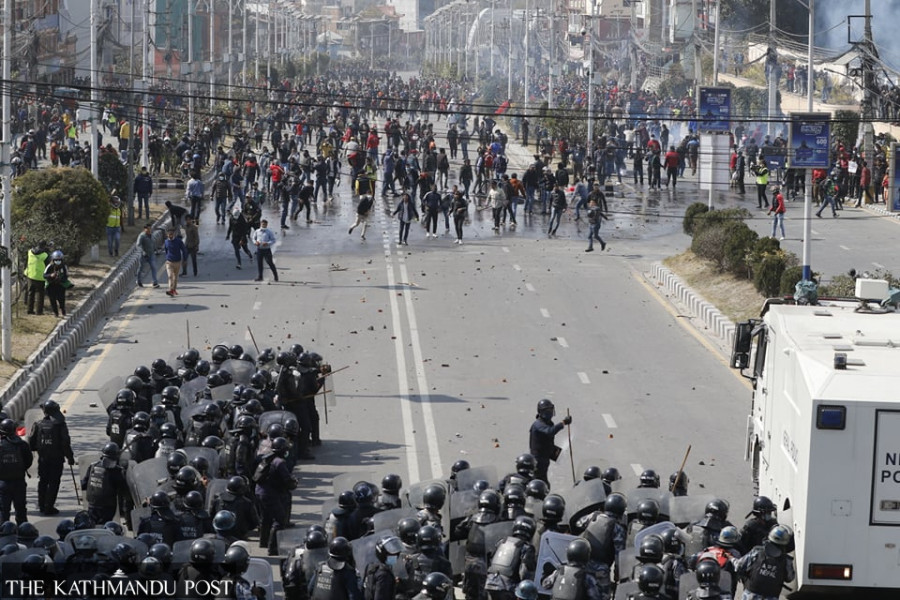
Sunday’s protest was peaceful in the beginning but turned violent in the afternoon. Keshav Thapa/TKP
On Sunday afternoon Tej Prasad Dahal, a motorcyclist working for a ride-sharing app, picked up a client from Balkot, Bhaktapur. The client was to be dropped off at Thapathali.
When Dahal, 45, arrived at Koteshwar, the Tinkune-New Baneshwar road was blocked by police due to violent protests against the Millennium Challenge Corporation compact in the Min Bhawan, New Baneshwar and Bijulibazar areas.
Police were diverting the vehicles headed for the city centre towards the Bagmati corridor.
General shutdown or Nepal banda used to be a common tactic to express dissent and protest by Nepal’s political parties in the past. Now again, with the tabling of the MCC compact in Parliament for ratification, many political parties and their affiliate groups opposed to the US grant have started hitting the street disrupting public mobility in Kathmandu.
“It was quite difficult to pass the corridor. It took me nearly two hours to reach Thapathali,” said Dahal, a father of two sons. Like Dahal, hundreds of people suffered due to the obstruction of one of the major roads in the capital.
Sanjib Das Sharma, spokesperson at the Metropolitan Traffic Police Division, said the protests at New Baneshwar, Bijulibazar and Minbhawan areas affected the traffic movement in the entire city.
“Traffic jams have already started getting severe in Kathmandu, and when there is obstruction in the core area, of course this has a ripple effect in the Valley’s entire traffic,” said Sharma.
According to the division office, at present over 1.2 million vehicles ply regularly in Kathmandu Valley.
Dahal, who has been working full time for the ride-sharing app for the past one and a half years, said on a regular day, he does up to eight trips, but on Sunday he had to satisfy with just three.
Like Dahal, Milan Danuwar, who drives a mini-bus on the Dudhpati-Ratnapark route, returned his bus to the garage after 10 am, due to the road blockage. “I just did one trip in the morning, but as protests started in the New Baneshwar area, I parked my bus,” said Danuwar, 37.
“We suffered a lot due to the pandemic-induced restrictions on public transport and now they are again blocking the roads. I wonder how will we survive if we are not allowed to work,” said Danuwar, who lives in Dudhpati of Bhaktapur. When asked about the MCC compact he said he is confused about it although everyone in his bus talks about it.
“Some people say it will bring development to the country and generate employment. And others say it is against Nepal’s national interests. I don’t know who to believe,” said Danuwar, a high school graduate.
“For us, work is the most important thing and we should be allowed to engage in our business without hindrance,” he added.
On Sunday when the ruling party was working to table the MCC compact, students and youths affiliated to the ruling CPN (Maoist Centre), CPN (Unified Socialist), and several other parties were protesting on the streets.
As Minister for Communication and Information Technology Gyanendra Bahadur Karki on behalf of Finance Minister Janardan Sharma tabled the $500 million American grant agreement in parliament amid obstructions by the main opposition CPN-UML, New Baneshwar area remained tense as protesters hurled brickbats at police, who tear-gassed the protesters and also used rubber bullets.
A viral video clip on social media that showed protesters digging out concrete blocks from the New Baneshwar pavements and hurling them at police met with widespread criticism from the public.
“What’s wrong with these intelligent people destroying public properties?” commented Bishow Parajuli, representative for the World Food Programme in India, reacting to the video clip shared by journalist Narayan Amrit on Twitter.
“But I don’t blame the protesters for the road obstructions because the root cause of the problem is the duplicity of our political parties,” said Dahal, who is originally from Dolakha district.
This is not the first time the New Baneshwar area saw violent protests this month. After Prime Minister Sher Bahadur Deuba on February 15 told his parliamentary party meeting that the MCC compact was set to be tabled in the House on the next day, a group of fringe leftist parties announced a general shutdown for February 16. Protesters in larger numbers gathered near the Parliament at New Baneshwar and attempted to breach the restricted area. Police detained 137 protesters.
“Now it looks like there will be more confrontation in the coming days as people are sharply divided over the MCC compact. And people like us who have to work every day for survival will suffer the most,” said Dahal.
According to Senior Superintendent Sudeep Giri of the Kathmandu Metropolitan Police Range, Sunday’s protest was peaceful in the beginning but went violent in the afternoon when protesters outnumbered police.
According to him, over 1,500 people had gathered around the Maitighar-Baneshwar area and were protesting until 6 pm in the evening.
“We had to use force as the protesters attempted to force their way towards the parliament building,” said Giri. “In the beginning, we only used water cannons to disperse the crowds but as the protesters grew more violent and attacked police with brickbats and petrol bombs, we had to use rubber bullets and tear gas to stop them.”
He said dozens including protesters and police were injured during Sunday’s protests. “We have arrested over 35 people who were behaving violently during the protest.”












